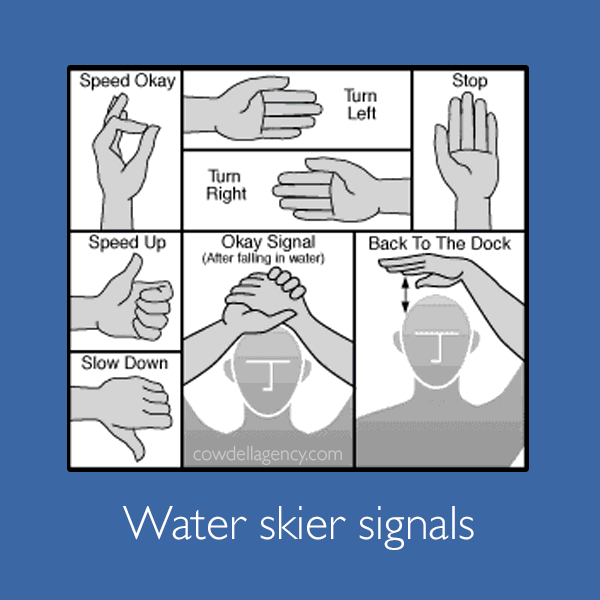
Water skiing is a team effort between the tow boat operator, observer and skier.
Boat Operator and Observer
- It's the law! Always have two people in the boat, one to operate the boat, one to observe the skier.
- Remain seated while the boat is in motion.
- Watch your speed. Going too fast can cause injuries when a skier falls. (Competition skiing occurs at 33-35 m.p.h.)
- Stay away from shallow water, swimming areas and people in the water (divers, swimmers, fishermen). Stay away from solid objects (other boats, docks, debris).
- Return immediately to pick up a fallen skier. Turn off the engine when assisting the skier into the boat.
Skier DOs
- Do... wear an approved personal flotation device (PFD), even if you are a good swimmer.
- Do... wear properly fitted bindings. Check your equipment for loose or damaged parts.
- Do... learn and use the water skier hand signals.
- Do... ski only during daylight hours, never at night.
- Do... watch the water ahead of you at all times. Run parallel to shore, and come in slowly when landing.
- Do... avoid falling forward when you fall. Signal the tow boat that all is well by clasping your hands over your head, or hold up your ski vertically. Continue to hold up your ski so that you can be seen by other boats.
- Do... learn new stunts progressively.
Skier DON'Ts
- Don't... yell "Hit It" until the tope is tight and tips are up.
- Don't... wrap your rope around any part of your body.
- Don't... put any part of your body (arm, leg, neck) through the bridle.
- Don't... ski directly ahead or to the side of another boat.
- Don't... ski doubles with different lengths of ropes.
- Don't... attempt a fast landing directly towards shore. Sit down if coming in too fast.
Weather Warnings
Keep your eye on the weather, and go ashore if the skies start to darken. You can be a target of lightning while swimming or boating.
- Lightning strikes at the highest projection. If an electrical storm with thunder and lightning is approaching, head for shore immediately.
- Stay away from high points (knolls, hills, etc.), metal objects, wire fences, poles and trees.
- Seek shelter in a cave or ditch. If no shelter is available, drop to your knees with only feet and knees touching the ground and your head bent. Remain that way until the storm is over.
From-Shore Rescues
It happens all too often. Someone struggles in the water as bystanders watch helplessly. Even swimmers may avoid attempting a rescue because of water conditions, or due to fear of being pulled under themselves.
Nearby items can often be used as “life preservers” to rescue a victim who is close to shore.
- If the victim is close to the shore or dock, lie flat to prevent being pulled into the water, have a friend hold your feet, and give the victim your hand. If necessary, extend your reach with a paddle, broom, rope, etc.
- If the victim is out of reach, toss anything that will float near, not at, the victim. This can be a capped empty jug, foam picnic cooler, chaise pad or water toy — even the spare tire from the trunk of your car.
An inflated tire is an excellent flotation device, and can be used by several individuals. A rescuer can use a tire as a personal flotation device to push out to the victim, and both victim and rescuer can use it for buoyancy as they return to shore. - Take a Cardio-Pulmonary Resuscitation (CPR) course through a qualified program. Knowing CPR could save a friend from death.
Hypothermia
Hypothermia can kill! Knowing what to look for and what to do can save your own life or the life of a friend.
Hypothermia can occur during a cold day spent fishing at the dock, rafting in a river, or even camping along a river’s edge. An overboard boating victim is likely to suffer some degree of hypothermia if in the water for over 15 minutes.
Hypothermia occurs when the body loses heat faster than it can be produced. Normal biological functions can no longer occur. When the body core reaches 90°F, unconsciousness may result. When it drop to 85°F, heart failure leads to death.
Preventing Hypothermia
- Be aware of the signs of hypothermia. Seek shelter as soon as any symptoms appear.
- Never drink alcohol while swimming, boating, playing or working near water. Alcohol can suppress your awareness of hypothermia.
- Wear sufficient clothing, including a hat. Dress in layers. Wool retains a higher percentage of insulating properties than most other fibers, even when wet.
- Avoid the wind. Wind can help deplete body heat trapped in clothing.
Signs of Hypothermia
- Uncontrollable shivering.
- Vague, slow, slurred speech.
- Memory lapse, incoherence.
- Immobile or fumbling hands.
- Frequent stumbling, lurching gait.
- Apparent exhaustion, inability to get up after rest.
Treating Hypothermia
If you treat hypothermia incorrectly, a victim can be in danger of “after drop,” the improper rewarming of cold, stagnant blood from the extremities returning to the body’s core. This may cause the body’s temperature to drop below the level necessary to sustain life.
Following are the recommended procedures to treat victims.
- Carry the victim to a sheltered area. Do not allow him or her to walk.|
- If the victim appears near death, administer heart massage and mouth to mouth resuscitation immediately.
- Remove all wet clothing.
In case of mild hypothermia, a warm shelter and dry clothing may be all that is needed. If the victim is conscious and can swallow without difficulty, a warm sugary drink may ease discomfort. Take care that liquid does not enter the victim’s lungs. In more serious cases, apply heat to the victim’s trunk by using a warm bath, shower, hot water bottles or heated blankets.
In the field, rescuers can remove their own clothes and use their own bodies to warm the victim’s naked body. A sleeping bag or blankets can also be used to conserve body heat.
- Do not...
• give the victim alcohol.
• rub the frozen body areas vigorously.
• wrap the victim in a blanket without an auxiliary heat source. This may cause “after drop.” - Seek medical attention as soon as possible.
Personal Flotation Devices (PFDs)
There’s no doubt about it — PFDs save lives. All recreational boats must have Coast Guard approved PFDs suitable for each person on board. But PFDs are not just for boaters. PFDs should be worn by all individuals who work or play near the water. If you regularly enjoy water activities, purchase a PFD of your own, one that fits and is readily at hand when your friends call. PFDs are rated for flotation ability — select the right one based on the activity for which it will be used. It could save your life.
 |
 |
 |
 |
 |
| Type I Offshore Life Jackets |
Type II Near-Shore Buoyant Vests |
Type III Flotation Aids |
Type IV Throwable Devices |
Type V Special Use Device |
Substance Abuse
Studies show that normal behavior can be affected by exposure to fresh air, ultraviolet light, glare, motion and noise. Adding alcohol and drugs (including prescription drugs) can result in an extremely explosive situation. Swimming, diving and boating accidents increase when your thought processes are impaired. If the water temperature is below 70°F, loss of body heat is increased by the presence of alcohol in the blood.
In addition, operating a recreational vessel while intoxicated is a Federal offense. Violators of the BWI (Boating While Intoxicated) law face a civil penalty of up to $1,000 or criminal penalty not to exceed $5,000, one year in prison, or both.













